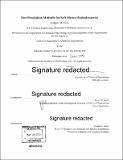| dc.contributor.advisor | James W. Swan. | en_US |
| dc.contributor.author | Fiore, Andrew M.(Andrew Michael) | en_US |
| dc.contributor.other | Massachusetts Institute of Technology. Department of Chemical Engineering. | en_US |
| dc.date.accessioned | 2019-11-12T17:38:33Z | |
| dc.date.available | 2019-11-12T17:38:33Z | |
| dc.date.copyright | 2019 | en_US |
| dc.date.issued | 2019 | en_US |
| dc.identifier.uri | https://hdl.handle.net/1721.1/122848 | |
| dc.description | Thesis: Ph. D., Massachusetts Institute of Technology, Department of Chemical Engineering, 2019 | en_US |
| dc.description | Cataloged from PDF version of thesis. | en_US |
| dc.description | Includes bibliographical references. | en_US |
| dc.description.abstract | This thesis describes the systematic development of methods to perform large scale dynamic simulations of hydrodynamically interacting colloidal particles undergoing Brownian motion. Approximations to the hydrodynamic interactions between particles are built from the periodic fundamental solution for flow at zero Reynolds number and are methodically improved by introducing the multipole expansion and constraints on particle dynamics. Ewald sum splitting, which decomposes the sum of slowly decaying interactions into two rapidly decaying sums evaluated indepently in real space and Fourier space, is used to accelerate the calculation and serves as the basis for a new technique to sample the Brownian displacements that is orders of magnitude faster than prior approaches. The simulation method is first developed using the ubiquitous Rotne-Prager approximation for the hydrodynamic interactions. | en_US |
| dc.description.abstract | Extension of the Rotne-Prager approximation is achieved via the multipole expansion, which introduces the notion of induced force moments whose value is determined from the solution of constraint problems (for example, rigid particles cannot deform in flow), and methods for handling these multipole-based constraints are illustrated. The multipole expansion converges slowly when particles are nearly touching, a problem which is functionally solved for dynamic simulations by including divergent lubrication interactions, in the style of Stokesian Dynamics. The lubrication interactions effectively introduce an additional constraint on the relative motion of closely separated particle pairs. This constraint is combined with the multipole constraints by developing a general method to handle nearly arbitrary dynamic constraints using saddle point matrices. Finally, the methods developed herein are applied to study sedimentation in suspensions of attractive colloidal particles. | en_US |
| dc.description.abstract | The simulation results are used to develop a predictive model for the hindered/promoted settling function that describes the mean sedimentation rate as a function of particle concentration and attraction strength. | en_US |
| dc.description.sponsorship | "The research in this thesis was supported by the MIT Energy Initiative Shell Seed Fund and NSF Career Award CBET-1 554398" | en_US |
| dc.description.statementofresponsibility | by Andrew M. Fiore. | en_US |
| dc.format.extent | 353 pages | en_US |
| dc.language.iso | eng | en_US |
| dc.publisher | Massachusetts Institute of Technology | en_US |
| dc.rights | MIT theses are protected by copyright. They may be viewed, downloaded, or printed from this source but further reproduction or distribution in any format is prohibited without written permission. | en_US |
| dc.rights.uri | http://dspace.mit.edu/handle/1721.1/7582 | en_US |
| dc.subject | Chemical Engineering. | en_US |
| dc.title | Fast simulation methods for soft matter hydrodynamics | en_US |
| dc.type | Thesis | en_US |
| dc.description.degree | Ph. D. | en_US |
| dc.contributor.department | Massachusetts Institute of Technology. Department of Chemical Engineering | en_US |
| dc.identifier.oclc | 1126283687 | en_US |
| dc.description.collection | Ph.D. Massachusetts Institute of Technology, Department of Chemical Engineering | en_US |
| dspace.imported | 2019-11-12T17:38:28Z | en_US |
| mit.thesis.degree | Doctoral | en_US |
| mit.thesis.department | ChemEng | en_US |
